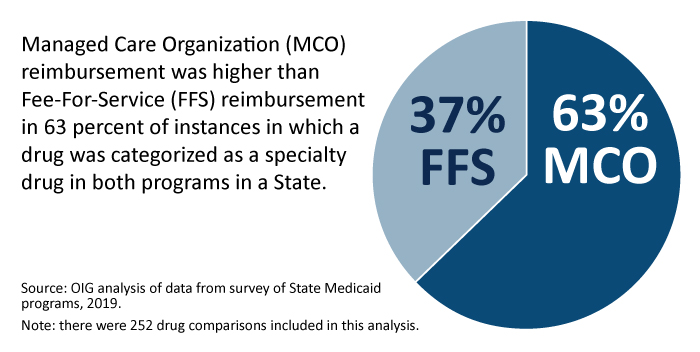Drug Spending
Updated: 12-16-2024
For over 25 years, the HHS Office of Inspector General has conducted work to assess drug spending in HHS programs. This work covers three domains: reimbursement, program compliance, and incentive alignment. This page is a compilation of completed reports, unimplemented recommendations, enforcement actions, and industry guidance.
Overview
-
According to data from the Centers for Medicare & Medicaid Services (CMS), U.S. prescription drug expenditures totaled $370 billion in 2019. Spending through Department of Health and Human Services (HHS) programs accounted for 41 percent ($151 billion) of this total. These HHS programs include Medicaid, Medicare Part B (largely for physician-administered drugs), and Medicare Part D (for most outpatient drugs). HHS also administers the 340B Drug Pricing Program (340B program), which enables safety net health care providers to purchase outpatient drugs at discounted prices.
OIG has a long history of successes in improving payment policy for prescription drugs, including a prominent role in highlighting vulnerabilities in the prior reimbursement methodologies in Medicare Part B and Medicaid. OIG's reports and enforcement work helped pave the way for legislative and programmatic changes that better aligned reimbursement amounts with provider acquisition costs, thereby saving the programs and their beneficiaries billions of dollars.
Today, OIG continues its commitment to promoting efficiency in HHS drug programs. OIG's portfolio on drug spending focuses on the following areas: reimbursement, program compliance, and incentive alignment.
-
Evolving drug reimbursement and rebate policies have a tremendous financial impact on Federal drug spending. OIG identifies circumstances where Medicare and Medicaid reimbursement rates for prescription drugs do not appropriately reflect provider acquisition costs, resulting in programs and beneficiaries paying too much. OIG work includes reviews of potential savings from various pricing and rebates methodologies and prescribing schemes in HHS programs; examining the effect of "bundling" payments on costs for drugs to treat end-stage renal disease (ESRD); and comparing the impact of different payment methodologies across the Medicare, Medicaid, and 340B programs. OIG plays a role in examining reimbursement rates for Part B drugs by reporting quarterly on Average Sale Prices (ASPs) and Average Manufacturer Prices (AMPs), at the request of Congress.
-
Drug manufacturers, State Medicaid agencies, and other entities must comply with statutory and program requirements. OIG has a body of work on program compliance, which include reviews of the effectiveness of Medicaid's rebate-collection efforts and whether all parties are adhering to 340B program requirements.
-
In certain situations, entities involved with HHS programs may have incentives not aligned with HHS program goals that adversely affect those programs and their beneficiaries out of pocket drug spending. OIG work includes examinations of Medicare Part D plan sponsors' insights into the services and information provided by pharmacy benefit managers (PBMs) and of conflicts of interest on pharmacy and therapeutics (P&T) committees.

 Report:
Report: